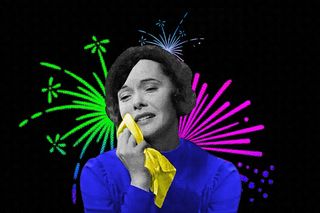
Are We Wired to Be Discontented?
The predisposition to dissatisfaction may be an evolutionary trait.

Something about the “light at the end of the tunnel” metaphor doesn’t quitesit right. It’s the absence of specificity: how long is the tunnel? Is it lit, even dimly so? Is there scope for congestion — the hectoring of cars and passengers chasing the elusive light? Will the light at the end stay for a while, or is there a succession of tunnels in store for us?
For some, the mind is bothered by the inconclusiveness innate to these questions. No metaphor is a perfect metaphor; yet,people manage to hook them to their dreams and philosophies to maintain hope every day. The pursuit of happiness is grand, driven by this metaphorical light too, but happiness, in and of itself, as a sustained state, is never achievable. Imagine having written a book, hundreds of reams of pages stacked on top of another. It’s exhilarating. But when are you starting work on your next book?
There’s evidence to suggest that the brain may be hardwired to choose discontentment over and over; dissatisfaction is where we start and, perhaps, where we end too. This tracks with our cultural reality: self-reported measures of happiness have stayed at similar levels for more than four decades now.
Biologically speaking, researchers have argued that the predisposition to misery is an evolutionary trait. According to psychiatrist Rafael Euba, “a state of contentment is discouraged by nature because it would lower our guard against possible threats to our survival.” This is a very formalistic way of looking at things, but in simple terms, it suggests that people are here to live and reproduce and continue to survive. Happiness or any semblance of contentment could deter us from that explicit goal.
“Perpetual bliss would completely undermine our will to accomplish anything at all – that’s why perfect contentment has probably been evolved out of us,” opined social psychologist Frank T. McAndrew.
Our anatomy offers some clues too. The brain is big and beautiful; each of its circuits and networks corresponds with certain neurological and intellectual functions that help us to live, breathe, decide. There is no brain tissue dedicated solely to dictating happiness, nothing “natural” or “neurological” governing its stream. On the other hand, our frontal lobe has developed over centuries to regulate people’s analytical and executive functions — giving us the ability to express language, control movement, plan, organize, and self-monitor.
However, the brain, interestingly, is not designed for our current reality; it struggles to articulate emotion, motivation, and behavior. Our brains are still wired to nomadic days when people needed to hunt and kill to survive. “If I throw a baseball at you, you’re going to reflexively duck your head, and there’s nothing you can do to override that with your conscious mind. Your ancient, subconscious, lizard-like visual system is doing that task,” explained David Linden, a professor of neuroscience at Johns Hopkins University in Baltimore. The brain is ancient in its design and slowly adapting, but that also means the ability to prioritize happiness isn’t simply within us — yet.
Related on The Swaddle:
This shows up in different psychological theories. There’s something called the hedonic treadmill, a theory that dictates our baseline happiness. We push and run towards a goal — a new job, a degree, a Friday evening checklist — in naive anticipation of the happiness it might bring us. But the surge of joy is instant and fleeting, as people quickly slide back to their ordinary state and begin the next chase of what will give them happiness. It’s the ultimate Sisyphian problem.
Why do we keep trying, then, despite knowing there is no promised certainty of success or joy in the end? The choice to undertake that ordeal still carries faint hints of comfort with misery in itself. Evolutionary psychology also speaks of the human brain’s “negativity bias,” the idea that the brain responds more sharply to negative images than positive or neutral images. Imagine looking at yourself in the mirror: do you see the blemishes or flattering aspects?
This state of discontentment is not a new phenomenon. Abd-al-Rahman III, Caliph of Córdoba, Spain, back in the 10th century, is said to have chanced upon the limitations of happiness long ago. His biological and material needs were satisfied beyond measure when he was alive: he was a great builder, thinker, and had a cultural legacy of forging a new dynasty. Reportedly, towards the end of his life when he calculated the exact number of days he felt happy, the answer was a sum total of 14. Two weeks’ worth of happiness over a course of almost 70 years.
It’s important to understand that there is little biological basis for happiness. As a social construct, still, it is the ultimate goal on which religious ideals and capitalistic pillars are placed. The divine lords promise unfathomable happiness in every garden: Heaven, Valhalla, Jannah, Vaikuntha. There’s a whole industry dedicated to the cause of happiness, wellness, and the power of positive thinking; some estimate it to be worth US$11 billion a year. The cultural consensus we’re being recruited into is that happiness is achievable and possible, and it is only due to one’s shortfalls — selfishness, misery, materialism, inherent emotional deficiencies — thathappiness remains elusive. That we may be wired to choose sadness, attacks the relentless social idea of chasing happiness, which is replete with problems of its own.
It’s not that happiness doesn’t exist, though. The brain recognizes positive and negative feelings, and the positivity does distill into an indescribable feeling of joy. But it’s rarely ever sustainable, and how we function, in many ways, is built on that foundation. In Aldous Huxley’s Brave New World, happiness adheres to its limitations; people live happy lives only with the aid of a drug called “soma.” If a human truly wants to be free, they must be afflicted with turbulence and difficult feelings; happiness is never a mainstay.
Sadness may be our natural predisposition, but that doesn’t mean we don our gloomy hats and commence a hopeless march. Dissatisfaction could be a powerful state of being. When stripped of unattainable and even exploitative cultural ambitions, maybe, we radically reimagine happiness as one that flows close to the shore and retreats, never standing still, always defying expectation. In our dissatisfaction, we may realize happiness cannot be boxed into permanence, and this wired misery may serve a purpose too.
Brazilian poet Vinicius de Moraes once spoke of a feature: “[Happiness is] like a feather flying in the air. It flies light, but not for very long.” But there is joy in watching the feature take flight, its wings bristling with hope, too — even if for seconds.
Saumya Kalia is an Associate Editor at The Swaddle. Her journalism and writing explore issues of social justice, digital sub-cultures, media ecosystem, literature, and memory as they cut across socio-cultural periods. You can reach her at @Saumya_Kalia.
Related


Why People ‘Sigh’ – And Why Others Find It Annoying
